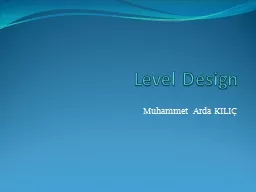

Muhammet Arda KILIÇ Level Design Introduction Levels inDifferent Games Components of Level Elements of Good Level The Process Who Does Level Design Introduction Level design is where all the different components of a game come together ID: 320877
Download Presentation The PPT/PDF document "Level Design" is the property of its rightful owner. Permission is granted to download and print the materials on this web site for personal, non-commercial use only, and to display it on your personal computer provided you do not modify the materials and that you retain all copyright notices contained in the materials. By downloading content from our website, you accept the terms of this agreement.
Slide1
Level Design
Muhammet
Arda KILIÇSlide2
Level Design
Introduction
Levels inDifferent Games
Components of Level
Elements of Good Level
The Process
Who Does Level Design?Slide3
Introduction
Level
design is where all the different components of a game come together.
I
n
some
ways creating a level is like putting together a jigsaw puzzle; to build the levels,
the level designer must make use of the game’s engine, art, and core gameplay.Slide4
Levels in Different Games
The
definition of a “level” varies greatly from game to game. It most commonly
refers
to
the game-world of side-
scrollers, first-person shooters, adventures, flight simulators and role-playing games.Slide5
Levels inDifferent Games
Level Separation
How a game is broken down into its component levels has a huge impact on the flow of
the game.
Level
Order
The designer should know how the order of the levels will affect the flow of gameplay, and should
be aware of how moving different levels around will affect it.Slide6
Components of Level
Action
Action
is the most obvious component of the levels for many
games
.
-
It is important to understand how much action the level contains.-Are
there “breaks” or intermissions between major conflicts
?
-
The
level designer must consider how the enemy
AI
functions
and what types of maps will lead to
conflicts
.Slide7
Components of Level
Exploration
Exploration
is a major part
of
many
action/adventure
games. Instead of just providing a bridge between different action set pieces, if properly designed the exploration can
actually be a lot of fun for players.Slide8
Components of Level
Puzzle
Solving
Sometimes progressing in a level involves more than just finding a path to the next
area
while
killing the adversaries that stand in your way Slide9
Components of Level
Storytelling
L
evels
are an integral part of telling a game’s
story
.If aim is to create a story based game, it only makes sense for the game’s levels and the story to work in synergy.Slide10
Components of Level
Aesthetics
A
big part of the level designer’s job is to balance appearance with the
other
requirements
of a given level.Too much detailed graphics can result the level running slowly or if the textures on a level isn’t obvious
player isn’t able to see where they
should
or should not be able to
go.
For this reason
the level designer must be fully aware of
the
level’s
appearance
will have on the gameplay.Slide11
Level Flow
-
Level flow of games differs from each ohter according to game genre.Slide12
Elements of Good Levels
Players Cannot Get
Stuck
Sub-Goals
Landmarks
Critical Path
Limited
BacktackingSuccess the First TimerNavigable Areas Clearly MarkedChoicesSlide13
The Process
Step 1.
Preliminary
-
if
the gameplay is in
a
close-to-final state.-Are your game mechanics nailed down?-Will more moves for the character be added?Slide14
The Process
Step 2. Conceptual and Sketched
Outline
What
sort of
challenges
will players face here?What sorts of environments best facilitate
those challenges?
How
exciting and nerve-racking is the gameplay in this level?
Where will
players
need to be rewarded
?
What story elements need to be conveyed through
the
level
?Slide15
The Process
Step 3. Base Architecture/Block
Out
Create
the base
layout with simple graphics
Step
4. Refine Architecture Until It Is Fun Refine a
rchitecture untilyour
level
starts feeling good and
navigating
it
starts to be fun.
Step 5. Base
Gameplay
Implement
the
gameplay your level will use
.Slide16
The Process
Step 6. Refine Gameplay Until It Is
Fun
Step
7. Refine
Aesthetics
Step 8. PlaytestingSlide17
Who Does Level Design?
one designer, one
level
team approachSlide18
Thank You